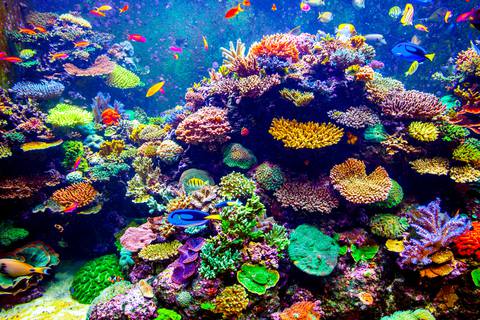These are difficult inconsistencies. As Richard Fortey observes: "Somehow it does not seem satisfying just to call them 'lucky ones' and leave it at that." If, as seems entirely likely, the event was followed by months of dark and choking smoke, then many of the insect survivors become difficult to account for. "Some insects, like beetles," Fortey notes, "could live on wood or other things lying around. But what about those like bees that navigate by sunlight and need pollen? Explaining their survival isn't so easy."
這些都是難以解釋的矛盾地方。正如理查德·福泰所說:“僅僅把它們稱做‘幸運兒’,這似乎總是不太令人滿意。”如果在事件發生之后幾個月里到處都是烏黑嗆人的煙霧,而情況似乎正是這個樣,那么你很難解釋許多昆蟲竟能存活下來。“有的昆蟲,比如甲蟲,”福泰指出,“可以在木頭或周圍別的東西上生活。但是,像蜜蜂這樣的在陽光里飛舞、需要花粉的動物怎么辦?說清楚它們幸存的原因是不太容易的。”

Above all, there are the corals. Corals require algae to survive and algae require sunlight, and both together require steady minimum temperatures. Much publicity has been given in the last few years to corals dying from changes in sea temperature of only a degree or so. If they are that vulnerable to small changes, how did they survive the long impact winter?
尤其是那個珊瑚。珊瑚需要藻類維持生命,而藻類需要陽光。二者都需要穩定的起碼溫度。在過去幾年里,已經有大量關于珊瑚因海水溫度變化了1攝氏度左右而死亡的報道。要是它們連小小的變化都受影響,它們是怎么挺過撞擊造成的漫長的冬天的?
There are also many hard-to-explain regional variations. Extinctions seem to have been far less severe in the southern hemisphere than the northern. New Zealand in particular appears to have come through largely unscathed even though it had almost no burrowing creatures. Even its vegetation was overwhelmingly spared, and yet the scale of conflagration elsewhere suggests that devastation was global. In short, there is just a great deal we don't know.
還有許多難以解釋的區域性差異。滅絕在南半球似乎遠不如在北半球那么嚴重。在很大程度上,尤其是新西蘭好像完好無損地挺了過來,而它又幾乎沒有穴居動物,連它的植物也絕大部分幸免于難,而別處的大火烈度表明,災難是全球性的。總之,還有許多問題我們搞不清楚。
來源:可可英語 http://www.ccdyzl.cn/Article/201812/574673.shtml











